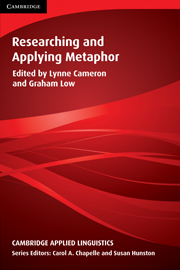Book contents
- Frontmatter
- Contents
- List of contributors
- Acknowledgements
- Conventions
- Series editors' preface
- Preface
- I KEY ISSUES IN METAPHOR RESEARCH
- II FROM THEORY TO DATA
- III ANALYSING METAPHOR IN NATURALLY OCCURRING DATA
- IV ANALYSING METAPHOR IN ELICITED DATA
- 10 “Captain of my own ship”: Metaphor and the discourse of chronic illness
- 11 “This paper thinks …”: Investigating the acceptability of the metaphor an essay is a person
- 12 When is a dead rainbow not like a dead rainbow? A context-sensitive method for investigating differences between metaphor and simile
- References
- Index
12 - When is a dead rainbow not like a dead rainbow? A context-sensitive method for investigating differences between metaphor and simile
Published online by Cambridge University Press: 05 October 2012
- Frontmatter
- Contents
- List of contributors
- Acknowledgements
- Conventions
- Series editors' preface
- Preface
- I KEY ISSUES IN METAPHOR RESEARCH
- II FROM THEORY TO DATA
- III ANALYSING METAPHOR IN NATURALLY OCCURRING DATA
- IV ANALYSING METAPHOR IN ELICITED DATA
- 10 “Captain of my own ship”: Metaphor and the discourse of chronic illness
- 11 “This paper thinks …”: Investigating the acceptability of the metaphor an essay is a person
- 12 When is a dead rainbow not like a dead rainbow? A context-sensitive method for investigating differences between metaphor and simile
- References
- Index
Summary
Nous avons supprimé le mot comme
Surrealist sloganIntroduction
The use of the experimental method in metaphor research is beset with a number of problems. Traditionally, experimental stimuli consist of a set of phrases containing some kind of metaphor, which are presented in isolation. Participants are then asked to make some kind of judgement, such as how apt they find the metaphors to be. Although this method has yielded useful information, it has two key faults. Firstly, divorcing metaphor from its context may have important implications for comprehension. This point was made by Black (1990), who argued that context was not only important for the comprehension of metaphor, but that in many cases it was absolutely necessary in order to distinguish whether a phrase was literal or metaphorical in the first place. Context may also be a crucial factor in studies investigating the differential features of different types of figurative language. For example, a simile can be considered to be more explicit than a metaphor (Glucksberg 8c Keysar, 1990) and so the extent to which the context permits an implicit statement may affect production of metaphor over simile. A second problem is that the examples of metaphor typically used in these experiments are created by the researchers. Although this allows for some manipulation of the kind of metaphor used, it leaves a very real possibility that the results are not typical either of the kind of metaphor used in real speech, or of metaphor used in poetic writing and literature, whichever is the topic of investigation.
- Type
- Chapter
- Information
- Researching and Applying Metaphor , pp. 249 - 268Publisher: Cambridge University PressPrint publication year: 1999
- 3
- Cited by



